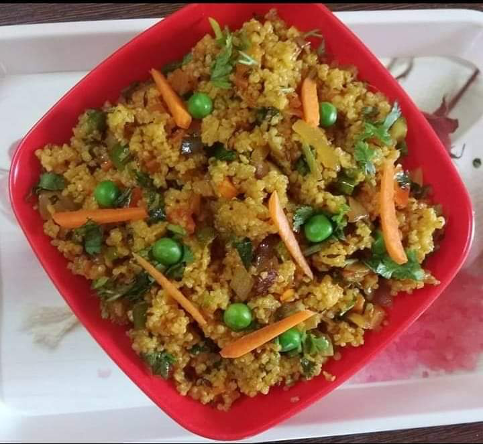
Vegetable Dalia
-
 Prep Time: 10
Prep Time: 10 -
 Cook Time: 20
Cook Time: 20 -
 Total Time: 30 mins
Total Time: 30 mins -
 Yield: 1 1x
Yield: 1 1x
Description
Dalia is very popular all over India. Vegetable Dalia is considered to be one of the simplest, healthier and scrumptious one pot vegan meal. This is low in fat, high in Iron and fiber, and its best dish for everyone. Vegetable Dalia is very easy where the Broken Wheat Aka cracked wheat/Dalia, vegetables, basic Indian spices are cooked with Onion, ginger, garlic based tempering. Bulgur Wheat, is a healthy alternative to whole wheat as it contains the outer bran, which makes it an excellent source of dietary fiber. Dalia is low in fats that not only aids in weight management but also prevents Obesity. So replacing wheat rotis or rice with Dalia is not a bad idea to boost your weight loss efforts. Dalia is also good for Diabetic and Gluten Intolerance patient.
Ingredients
- 1/2 cup Dalia
- 1 small onion, finely chopped
- 1/2 tsp ginger paste
- 1 green chili, finely chopped
- 1 small tomato, finely chopped
- 1/4 cup chopped carrots
- ¼ cup chopped potatoes
- ¼ cup shelled green peas/fresh or frozen
- 2 cups water
- ½ tsp cumin seeds
- 1 tsp cooking oil
- salt as required
- ¼ tsp Red chili powder
- ¼ tsp turmeric powder
Instructions
1) Heat cooking oil in a pan. Add cumin seeds and let it crackle.
2) Add chopped onions and sauté till they become transparent. Now add chopped ginger, green chilies and sauté properly.
3) Add chopped tomato and sauté for 1 minute. Now add all the veggies of your choice and sauté till the vegetables are soft and tender.
4) Rinse the Dalia and add to the veggies. Stir for 3-4 minutes. Add 2 cups water and all the vegetables. Stir well occasionally till Dalia is cooked well.
5) If the Dalia has not cooked completely, then add some more water and cook on low medium flame without the lid till they are softened.
6) Garnish vegetable Dalia with chopped coriander leaves and sprinkle lemon juice on top.
7) Serve hot with coriander chutney.
Nutrition
- Serving Size: 1
- Calories: 250 - 260 KCAL
- Fat: 12 – 15 GM
- Carbohydrates: 40 - 50 GM
- Protein: 6 – 8 GM




